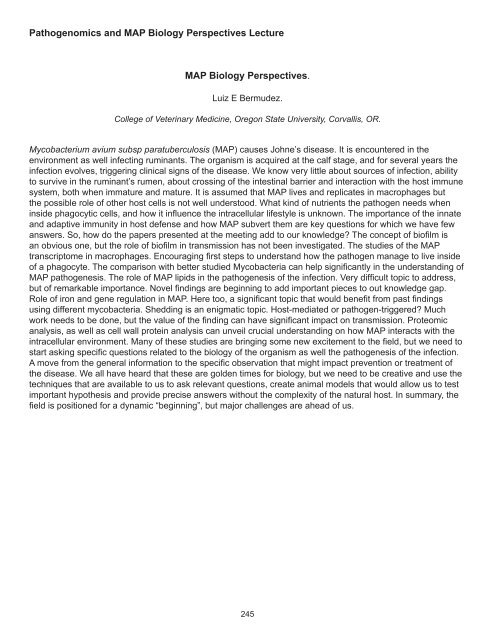Proceedings of the 10th International Colloquium on Paratuberculosis
Proceedings of the 10th International Colloquium on Paratuberculosis
Proceedings of the 10th International Colloquium on Paratuberculosis
You also want an ePaper? Increase the reach of your titles
YUMPU automatically turns print PDFs into web optimized ePapers that Google loves.
Pathogenomics and MAP Biology Perspectives Lecture<br />
MAP Biology Perspectives.<br />
Luiz E Bermudez.<br />
College <str<strong>on</strong>g>of</str<strong>on</strong>g> Veterinary Medicine, Oreg<strong>on</strong> State University, Corvallis, OR.<br />
Mycobacterium avium subsp paratuberculosis (MAP) causes Johne’s disease. It is encountered in <str<strong>on</strong>g>the</str<strong>on</strong>g><br />
envir<strong>on</strong>ment as well infecting ruminants. The organism is acquired at <str<strong>on</strong>g>the</str<strong>on</strong>g> calf stage, and for several years <str<strong>on</strong>g>the</str<strong>on</strong>g><br />
infecti<strong>on</strong> evolves, triggering clinical signs <str<strong>on</strong>g>of</str<strong>on</strong>g> <str<strong>on</strong>g>the</str<strong>on</strong>g> disease. We know very little about sources <str<strong>on</strong>g>of</str<strong>on</strong>g> infecti<strong>on</strong>, ability<br />
to survive in <str<strong>on</strong>g>the</str<strong>on</strong>g> ruminant’s rumen, about crossing <str<strong>on</strong>g>of</str<strong>on</strong>g> <str<strong>on</strong>g>the</str<strong>on</strong>g> intestinal barrier and interacti<strong>on</strong> with <str<strong>on</strong>g>the</str<strong>on</strong>g> host immune<br />
system, both when immature and mature. It is assumed that MAP lives and replicates in macrophages but<br />
<str<strong>on</strong>g>the</str<strong>on</strong>g> possible role <str<strong>on</strong>g>of</str<strong>on</strong>g> o<str<strong>on</strong>g>the</str<strong>on</strong>g>r host cells is not well understood. What kind <str<strong>on</strong>g>of</str<strong>on</strong>g> nutrients <str<strong>on</strong>g>the</str<strong>on</strong>g> pathogen needs when<br />
inside phagocytic cells, and how it influence <str<strong>on</strong>g>the</str<strong>on</strong>g> intracellular lifestyle is unknown. The importance <str<strong>on</strong>g>of</str<strong>on</strong>g> <str<strong>on</strong>g>the</str<strong>on</strong>g> innate<br />
and adaptive immunity in host defense and how MAP subvert <str<strong>on</strong>g>the</str<strong>on</strong>g>m are key questi<strong>on</strong>s for which we have few<br />
answers. So, how do <str<strong>on</strong>g>the</str<strong>on</strong>g> papers presented at <str<strong>on</strong>g>the</str<strong>on</strong>g> meeting add to our knowledge? The c<strong>on</strong>cept <str<strong>on</strong>g>of</str<strong>on</strong>g> bi<str<strong>on</strong>g>of</str<strong>on</strong>g>ilm is<br />
an obvious <strong>on</strong>e, but <str<strong>on</strong>g>the</str<strong>on</strong>g> role <str<strong>on</strong>g>of</str<strong>on</strong>g> bi<str<strong>on</strong>g>of</str<strong>on</strong>g>ilm in transmissi<strong>on</strong> has not been investigated. The studies <str<strong>on</strong>g>of</str<strong>on</strong>g> <str<strong>on</strong>g>the</str<strong>on</strong>g> MAP<br />
transcriptome in macrophages. Encouraging first steps to understand how <str<strong>on</strong>g>the</str<strong>on</strong>g> pathogen manage to live inside<br />
<str<strong>on</strong>g>of</str<strong>on</strong>g> a phagocyte. The comparis<strong>on</strong> with better studied Mycobacteria can help significantly in <str<strong>on</strong>g>the</str<strong>on</strong>g> understanding <str<strong>on</strong>g>of</str<strong>on</strong>g><br />
MAP pathogenesis. The role <str<strong>on</strong>g>of</str<strong>on</strong>g> MAP lipids in <str<strong>on</strong>g>the</str<strong>on</strong>g> pathogenesis <str<strong>on</strong>g>of</str<strong>on</strong>g> <str<strong>on</strong>g>the</str<strong>on</strong>g> infecti<strong>on</strong>. Very difficult topic to address,<br />
but <str<strong>on</strong>g>of</str<strong>on</strong>g> remarkable importance. Novel findings are beginning to add important pieces to out knowledge gap.<br />
Role <str<strong>on</strong>g>of</str<strong>on</strong>g> ir<strong>on</strong> and gene regulati<strong>on</strong> in MAP. Here too, a significant topic that would benefit from past findings<br />
using different mycobacteria. Shedding is an enigmatic topic. Host-mediated or pathogen-triggered? Much<br />
work needs to be d<strong>on</strong>e, but <str<strong>on</strong>g>the</str<strong>on</strong>g> value <str<strong>on</strong>g>of</str<strong>on</strong>g> <str<strong>on</strong>g>the</str<strong>on</strong>g> finding can have significant impact <strong>on</strong> transmissi<strong>on</strong>. Proteomic<br />
analysis, as well as cell wall protein analysis can unveil crucial understanding <strong>on</strong> how MAP interacts with <str<strong>on</strong>g>the</str<strong>on</strong>g><br />
intracellular envir<strong>on</strong>ment. Many <str<strong>on</strong>g>of</str<strong>on</strong>g> <str<strong>on</strong>g>the</str<strong>on</strong>g>se studies are bringing some new excitement to <str<strong>on</strong>g>the</str<strong>on</strong>g> field, but we need to<br />
start asking specific questi<strong>on</strong>s related to <str<strong>on</strong>g>the</str<strong>on</strong>g> biology <str<strong>on</strong>g>of</str<strong>on</strong>g> <str<strong>on</strong>g>the</str<strong>on</strong>g> organism as well <str<strong>on</strong>g>the</str<strong>on</strong>g> pathogenesis <str<strong>on</strong>g>of</str<strong>on</strong>g> <str<strong>on</strong>g>the</str<strong>on</strong>g> infecti<strong>on</strong>.<br />
A move from <str<strong>on</strong>g>the</str<strong>on</strong>g> general informati<strong>on</strong> to <str<strong>on</strong>g>the</str<strong>on</strong>g> specific observati<strong>on</strong> that might impact preventi<strong>on</strong> or treatment <str<strong>on</strong>g>of</str<strong>on</strong>g><br />
<str<strong>on</strong>g>the</str<strong>on</strong>g> disease. We all have heard that <str<strong>on</strong>g>the</str<strong>on</strong>g>se are golden times for biology, but we need to be creative and use <str<strong>on</strong>g>the</str<strong>on</strong>g><br />
techniques that are available to us to ask relevant questi<strong>on</strong>s, create animal models that would allow us to test<br />
important hypo<str<strong>on</strong>g>the</str<strong>on</strong>g>sis and provide precise answers without <str<strong>on</strong>g>the</str<strong>on</strong>g> complexity <str<strong>on</strong>g>of</str<strong>on</strong>g> <str<strong>on</strong>g>the</str<strong>on</strong>g> natural host. In summary, <str<strong>on</strong>g>the</str<strong>on</strong>g><br />
field is positi<strong>on</strong>ed for a dynamic “beginning”, but major challenges are ahead <str<strong>on</strong>g>of</str<strong>on</strong>g> us.<br />
245






